Territories — Legality of Jewish Settlements
http://www.mythsandfacts.org/replyonlineedition/chapter-9.html
Border Changes As Arabs Initiate Wars of Aggression
In 1947 Jews accepted the UN “Partition Plan” that recommended a sovereign independent Jewish State. All Arab countries rejected the “Partition Plan,” and tried to wipe Israel off the face of the earth. Time and again Israel has returned land it gained in these Arab wars of aggression, in the hope that this will deliver peace and stability. It did not.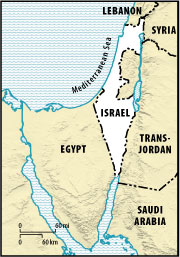 1949
1949
Israel boundaries after Israel War of Independence.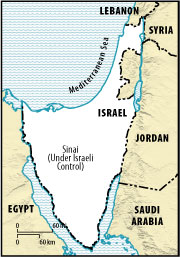 1956
1956
Sinai Campaign; Israel gains control over the Sinai Peninsular territory.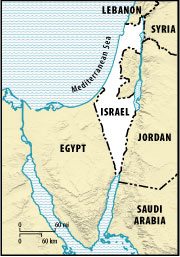 1957
1957
Israel agrees to withdraws its troops from the Sinai Peninsular and the Gaza Strip, handing over these territories back to Egypt.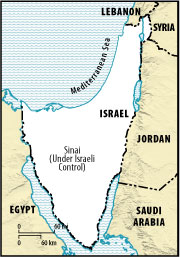 1967
1967
Israel boundaries following the Six Day War. Egypt, Jordan and Syria in a war of aggression, loose the territories of the Sinai Peninsular, the West Bank and the Golan Heights. For the first time Israel is in control of Jewish Mandated Palestine.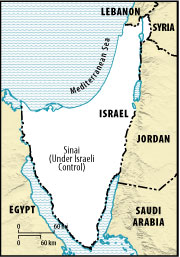 1973
1973
Israel boundaries following the Yom Kippur War. In a clear act of aggression Egypt and Syria attacked the State of Israel, but were driven away.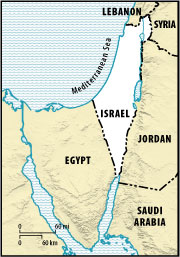 1979 – Present
1979 – Present
On March 26, 1979, Israel and Egypt signed a peace treaty on the White House lawn. Israel returned the Sinai Peninsular territory to Egypt.
In paragraph 120 of the Court’s opinion, the ICJ declares:
“The Court concludes that the Israeli settlements in the Occupied Palestinian Territory (including East Jerusalem) have been established in breach of international law.”The ICJ based its conclusion on the inappropriate use of an article of the Fourth Geneva Convention which stipulates:
“The Occupying Power shall not deport or transfer parts of its own civilian population into the territory it occupies.”This was coupled with a host of anti-Israeli UN General Assembly resolutions passed in the 1990s that describe the West Bank and Gaza as “Palestinian Occupied Territories” and declare Israeli settlements – including hundreds of thousands of Jewish Jerusalemites living in numerous new neighborhoods built since 1967 – to be illegal settlers.
For example, in paragraph 19 of the opinion, the ICJ notes that in 1997 the Security Council rejected two one-sided draft resolutions that sought to brand Israeli settlements as illegal (draft S/1997/1991 and draft S/1997/2412). The ICJ then proceeds to solemnly describe how “the Arab Group” maneuvered to by-pass the Security Council and to subsequently pass General Assembly Resolution ES-10/2 that “expressed its [General Assembly] conviction” and:
“… condemned the ‘illegal Israeli actions’ in occupied East Jerusalem and the rest of the Occupied Palestinian Territory, in particular the construction of settlements in that territory.”The ICJ leads the reader to believe that expressing “conviction” in regard to the so-called “illegal Israeli actions in occupied East Jerusalem and the rest of the Occupied Palestinian Territory” is sufficient to make the document a source of law.
The General Assembly request of the ICJ’s advisory opinion reads:
“Recalling in particular relevant United Nations resolutions affirming that Israeli settlements in the Occupied Palestinian Territory, including East Jerusalem, are illegal and an obstacle to peace and to economic and social development as well as those demanding the complete cessation of settlement activities.”3Again, the ICJ treats its reference to “United Nations Resolutions” as if it was a source of law, all without checking its accuracy or legal standing.
The UN Charter does not grant the General Assembly or the International Court of Justice the authority to assign or affect ‘ownership’ of the Territories.
As incredulous as it may be, the ICJ chose to ignore the actual powers vested in the UN General Assembly. A host of anti-Israel resolutions passed annually by the Assembly are not legally binding documents by any measure. One need only to read Article 10 of the UN Charter:“The General Assembly may discuss any questions or any matters within the scope of the present Charter or relating to the powers and functions of any organs provided for in the present Charter, and, except as provided in Article 12, may make recommendations to the Members of the United Nations or to the Security Council or to both on any such questions or matters” [italics by author].Schwebel, the former president of the International Court of Justice, has written that:
“… the General Assembly of the United Nations can only, in principle, issue ‘recommendations’ which are not of a binding character, according to Article 10 of the Charter of the United Nations.”4Schwebel also cites the (1950) opinion of Judge, Sir Hersch Lauterpacht, a former member judge of the International Court of Justice, who declared that:
“… the General Assembly has no legal power to legislate or bind its members by way of recommendation.”Yet, another former ICJ judge, Sir Gerald Fitzmaurice, has been just as resolute in rejecting what he labeled the “illusion” that a General Assembly resolution can have “legislative effect.”5
Academics and renowned international law experts also agree. Professor Stone illuminates this subject by pointing out:
“In his book The Normative Role of the General Assembly of the United Nations and the Declaration of Principles of Friendly Relations, Professor Gaetano Arangio-Ruiz6 is led to conclude that the General Assembly lacks legal authority either to enact or to ‘declare’ or ‘determine’ or ‘interpret’ international law so as legally to bind states by such acts, whether these states be members of the United Nations or not, and whether these states voted for or against or abstained from the relevant vote or did not take part in it.”7, 8Certain General Assembly resolutions may be recognized as “declaratory,” but no more. Among Schwebel conclusions:
“… certain resolutions of the General Assembly – viewed as expressions of the assembled States of the world community … which treat questions of international law which are not the subject of principles found in the United Nations Charter may be recognized to be declaratory, though not creative, of international law, provided that they are:
(i) adopted with the support of all assembled States, or, at any rate, of all the groups of States represented in the General Assembly, including major States that are not members of a group, such as the United States of America and China.”
The Territories and the war of words.
One can easily trace the General Assembly’s attempts tolegislate changes in the status of the Territories. How the definition of the status of the Territories was doctored is well documented on the website of the Palestinian delegation to the United Nations that posts landmark pro-Palestinian decisions. Examination reveals how over the years UN General Assembly resolutions and the wording of resolutions by sub-committees moves from “territories” to “occupied territories” to “Occupied Territories” and “Arab territories” to “occupied Palestinian territories” to “Occupied Palestinian Territory” and “occupied Palestinian territory, including Jerusalem”:- Resolution 3236 (XXIX)9 passed in November 1974 speaks of “the question of Palestine”;
- Resolution 38/5810 in December 1983 speaks of “Arab territories” and “occupied territories”;
- Resolution 43/17611 passed in December 1988 expresses sentiments suggesting Palestinian entitlement – speaking of “the Palestinian people[’s] right to exercise their sovereignty over their territory occupied since 1967”;
- Resolution 51/13312 passed in December 1996 adds Jerusalem in particular – speaking of “occupied Palestinian territory, including Jerusalem, and the occupied Syrian Golan”;
- Resolution 52/25013 passed in July 1998 fully “assigns title” – speaking of “Occupied Palestinian Territory,” a designation that is frequently used in subsequent resolutions.
It should be noted that the coining of the term “Occupied Palestinian Territory” by the General Assembly, and all the more so its ‘adoption’ by the International Court of Justice, is contrary to, and totally incompatible with, Article 12 of the UN Charter which states:
“While the Security Council is exercising in respect of any dispute or situation the functions assigned to it in the present Charter, the General Assembly shall not make any recommendation with regard to that dispute or situation unless the Security Council so requests” [italics by author].
International law allows for “just wars” and “lawful occupation.”
Resolutions 242 and 338 (discussed in Chapter 8) are the cornerstones for how a “just and lasting peace” should be achieved. The term ‘Occupied Palestinian Territory’ does not appear in either, not even the term ‘occupied territory.’ Resolution 242 affirms that:“… fulfillment of the Charter principles requires the establishment of a just and lasting peace in the Middle East which should include the application of both the following principles: Withdrawal of Israeli armed forces from territories occupied in the recent conflict; Termination of all claims or states of belligerency and respect for and acknowledgement of the sovereignty, territorial integrity and political independence of every State in the area and their right to live in peace within secure and recognized boundaries free from threats or acts of force.”The ICJ ignores that there is such a quality as a “lawful occupation.” In essence the ICJ seeks to overturnSecurity Council Resolutions 242 and 338, and to de-legitimize Israel’s right to claim any territory over the Green Line, even for self-defence.
In paragraph 74 of the opinion, the ICJ prefers a highly questionable, abridged rendition of these two core documents in a way that makes it appear as if Israel was an aggressor:
“On 22 November 1967, the Security Council unanimously adopted resolution 242 (1967), which emphasized [E.H., Principle I] the inadmissibility of acquisition of territory by war and [E.H., Principle II] called for the ‘Withdrawal of Israel armed forces from territories occupied in the recent conflict,’ and [E.H., Principle III] ‘Termination of all claims or states of belligerency.’”
ICJ selective writing falsifies historical documents.
The ICJ misleads the readers by simply removing from the second principle [Principle II above] the need, as stated in Resolution 242, for “secure and recognized boundaries” that will not invite aggression. In any case, the ICJ cannot override Security Council resolutions nor can it edit or fix them. Such doctored use of “the inadmissibility of the acquisition of territory by force” is disingenuous.It is impossible to believe that the ICJ was unfamiliar with the basic rules governing the workings of the UN that are most relevant in understanding the meaning of the Security Council’s power and the two types of resolutions it may adopt:
Resolutions adopted under Chapter VI of the UN_Charter – Recommending “Pacific Resolution of Dispute”:
Resolutions the Security Council adopts under Chapter VI are intended to be followed and implemented via negotiated settlements between concerned parties. One of the UN resolutions adopted under Chapter VI of the UN Charter is Resolution 242, adopted after the 1967 Six-Day War. It calls on Israel and its Arab neighbours to accept the resolution through negotiation, arbitration and conciliation. Under Chapter VI of the UN Charter, the recommendations of UN Resolution 242 cannotbe imposed on the parties concerned, as Arab leaders often argue. In fact, the title of Chapter VI also offers a clue to its nature, for it deals with “Pacific Resolution of Disputes.”Resolutions adopted under Chapter VII of the UN Charter – Dealing with the “Threats to Peace …”:
In contrast, resolutions adopted by the Security Council under Chapter VII invest the Security Council with power to issue stringent resolutions that require nations to comply with the terms and directives set forth in the resolution. This leaves no room to negotiate a settlement with the affected parties. Thus, Chapter VII deals with “Threats to Peace, Breaches of the Peace and Acts of Aggression.”When Iraq invaded Kuwait in 1990, the Security Council adopted resolutions under Chapter VII that only required the aggressor, Iraq, to comply.14
Had Israel been an aggressor – where the territories were “occupied territories” taken by force in an unjust war – Resolution 242 would have been adopted under Chapter VII of the UN Charter, requiring Israel to comply … and not under Chapter VI.
In paragraph 26 of its opinion, the ICJ notes that Chapter VII empowers the Security Council to “require enforcement by coercive action,” thus implying that this Chapter is somehow relevant to these proceedings. Chapter VI isn’t even mentioned in the ICJ’s opinion – not in general and not with regard to Resolutions 242 or 338, although the Bench cites “242 (1967)” no less than seven times, providing ample opportunity to clarify that 242 adopted under Chapter VI of the UN Charter is intended to be followed and implemented via negotiated settlements between the concerned parties, and not by this Court.
Ignoring just wars and legal occupation.
It is important to note here that the ICJ refuses to even acknowledge the existence of scholarly literature that addresses the issue of seizure of territory in just warswritten by internationally respected, former members of the ICJ. The ICJ simply turns a blind eye to the fact that some wars are just wars and not all occupations areillegal – as in the Israeli case, so clearly reflected by the unanimous adoption of UN Security Council Resolution 242 under Chapter VI.As noted earlier, Lauterpacht pointed out in his writing that:
“… territorial change cannot properly take place as a result of the ‘unlawful’ use of force. But to omit the word ‘unlawful’ is to change the substantive content of the rule and to turn an important safeguard of legal principle into an aggressor’s charter. For if force can never be used to effect lawful territory change, then, if territory has once changed hands as a result of the unlawful use of force, the illegitimacy of the position thus established is sterilized by the prohibition upon the use of force to restore the lawful sovereign. This cannot be regarded as reasonable or correct.”15This argument, which is widely recognised, goes unnoticed or is consciously and purposely ignored by the Court.
The ICJ’s sweeping ‘adoption’ of the General Assembly’s resolutions – as if they were legally binding or a source of international law – and the ICJ’s unauthorized ‘illegal transfer’ of unallocated disputed territories to one of the sides in the conflict, is all the more ironic in light of the ICJ’s main contention: that Israel’s actions are primarily political and not security motivated, and that these actions constitute a fait accompli, declaring in paragraph 121 of the opinion:
“The Court considers that the construction of the wall and its associated régime create a ‘fait accompli’ on the ground that could well become permanent, in which case, and notwithstanding the formal characterization of the wall by Israel, it would be tantamount to de facto annexation.”This begs the question: Are the ICJ’s own actions in arbitrarily handing over ownership and title to all territories beyond the Green Line to the Palestinians – including East Jerusalem – not tantamount to unlawfulde facto annexation?
Professor Stone cites in his writings that in 1975 the ICJ has been:
“insistent, not least as regards [to] questions ofterritorial title, that the rules and concepts of international law have to be interpreted ‘by reference to the law in force’ and ‘the State practice’ at the relevant period [italics by author].
“Judge de Castro in his Separate Opinion (ibid., 127, at 168 ff.) declared the principle tempus regit factum as a recognized principle of international law. He continued (p. 169): ‘Consequently, the creation of ties with or titles to a territory must be determined according to the law in force at the time. ... The rule tempus regit factum must also be applied to ascertain the legal force of new facts and their impact on the existing situation.’ He went on to illustrate this influence of ‘new facts and new law’ by reference to the impact on the suppression of the colonial status of Western Sahara by the principles concerning non-self-governing territories emanating from the United-Nations Charter and the later application to them of the principle of Self-determination (pp. 169-71). This limiting rider has reference to the appearance of new principles of international law, overriding the different principles on which earlier titles are based. But, of course, it can have no application to vested titles based, as was the very territorial allocation between the Jewish and Arab peoples, on the principle of self-determination itself.”16If the so-called West Bank and Gaza were indeed occupied territory – belonging to someone else and unjustly seized by force – there could be no grounds for negotiating new borders, as UN Security Council Resolution 242 implies.
The ICJ charges that Jewish settlements in the West Bank are populated by settlers ‘deported by force.’
Once the ICJ has ‘established evidence’ that the West Bank and Gaza are unlawfully occupied territories, it then applies this status to the Fourth Geneva Conference17 de jure, stating in paragraph 120 of the opinion that:“As regards these settlements, the Court notes that Article 49, paragraph 6, of the Fourth Geneva Convention provides: ‘The Occupying Power shall not deport or transfer parts of its own civilian population into the territory it occupies.’One can hardly believe this baseless ICJ assertion that Israel used “deportation” and “forced transfer” of its own population into “occupied territories.”
“In this respect, the information provided to the Court shows that, since 1977, Israel has conducted a policy and developed practices involving the establishment of settlements in the Occupied Palestinian Territory, contrary to the terms of Article 49, paragraph 6, just cited” [italics by author].
The Court attempts to broaden the definition of Article 49 to possibly ‘fit’ some wrong doing on the part of the State of Israel, all with no reference to law, adding:
“That provision prohibits not only deportations or forced transfers of population such as those carried out during the Second World War, but also any measures taken by an occupying Power in order to organize or encourage transfers of parts of its own population into the occupied territory.”In the above conclusion, the ICJ fails to disclose the content of the “information provided” (information the Court based its decision on), and the anonymous‘authorities’ that provided such. Anyone interested in the subject at hand is aware of the difficulties the Israeli Government faces in its decision to relocate some Israeli settlements out of the “Territories,” a fact that seems to be contrary to the “information provided” to the ICJ.
Professor Stone touches on the applicability of Article 49 of the Geneva Convention. Writing on the subject in 1980:
“… that because of the ex iniuria principle, Jordan never had nor now has any legal title in the West Bank, nor does any other state even claim such title. Article 49 seems thus simply not applicable. (Even if it were, it may be added that the facts of recent voluntary settlements seem not to be caught by the intent of Article 49 which is rather directed at the forced transfer of the belligerent’s inhabitants to the occupied territory, or the displacement of the local inhabitants, for other than security reasons.) The Fourth Geneva Convention applies only, according to Article 2, to occupation of territory belonging to ‘another High Contracting Party’; and Jordan cannot show any such title to the West Bank, nor Egypt to Gaza.”Support to Stone’s assertion can be found in Lauterpacht’s writing in 1968:
“Thus Jordan’s occupation of the Old City–and indeed of the whole of the area west of the Jordan river–entirely lacked legal justification; and being defective in this way could not form any basis for Jordan validly to fill the sovereignty vacuum in the Old City [and whole of the area west of the Jordan river].”18Rostow concludes that the Convention is not applicable to Israel’s legal position and notes:
“The opposition to Jewish settlements in the West Bank also relied on a legal argument – that such settlements violated the Fourth Geneva Convention forbidding the occupying power from transferring its own citizens into the occupied territories. How that Convention could apply to Jews who already had a legal right, protected by Article 80 of the United Nations Charter, to live in the West Bank, East Jerusalem, and the Gaza Strip, was never explained.”19It seems that the International Court of Justice “never explained” it either.
By default, ICJ support of the “Mandate for Palestine” suggests it is actually supporting Jewish settlement in Palestine. Is the ICJ confused?
The ICJ concluded that under the Fourth Geneva Conference, Jewish settlements in the “Territories” are illegal, which brings up the need to reconcile two of the ICJ’s conflicting positions:The first, as noted above, is the ICJ opinion regarding the illegal Jewish settlements in the “Territories.”
The second, refers to the ICJ ‘adoption’ of the “Mandate for Palestine” – a document which under Article 6 testifies to the legality of Jewish settlements in Palestine that:
“encourage, in co-operation with the Jewish agency referred to in Article 4, [building] close settlement by Jews on the land, including State lands and waste lands not required for public purposes”20[italics by author].The ICJ ignores that under both international convention21 and Article 80 of the UN Charter, all of western Palestine is legally open to settlement by Jews, and at best, the West Bank and Gaza are unallocated territory left over from the British Mandate to which there are two claimants.
Paragraph 88 of the Court’s opinion stated that:
“… the ultimate objective of the sacred trust” referred to in Article 22, paragraph 1, of the Covenant of the League of Nations “was the self-determination … of the peoples concerned.”The ICJ seems confused. It attempts to links the “sacred trust” to the wrong “people concerned”!
UN Charter and Article 80.
International law, the UN Charter, and specifically Article 80 of the UN Charter implicitly recognize the “Mandate for Palestine” of the League of Nations. This Mandate granted Jews the irrevocable right to settle in the area of Palestine, anywhere between the Jordan River and the Mediterranean Sea. Rostow explains:“This right is protected by Article 80 of the United Nations Charter. The Mandates of the League of Nations have a special status in international law, considered to be trusts, indeed ‘sacred trusts.’It is interesting to learn how Article 80 made its way into the UN Charter. Professor Rostow recalls:
“Under international law, neither Jordan nor the Palestinian Arab ‘people’ of the West Bank and the Gaza Strip have a substantial claim to the sovereign possession of the occupied territories.”22
“I am indebted to my learned friend Dr. Paul Riebenfeld, who has for many years been my mentor on the history of Zionism, for reminding me of some of the circumstances which led to the adoption of Article 80 of the Charter. Strong Jewish delegations representing differing political tendencies within Jewry attended the San Francisco Conference in 1945. Rabbi Stephen S. Wise, Peter Bergson, Eliahu Elath, Professors Ben-Zion Netanayu and A. S. Yehuda, and Harry Selden were among the Jewish representatives. Their mission was to protect the Jewish right of settlement in Palestine under the mandate against erosion in a world of ambitious states. Article 80 was the result of their efforts.”
The ICJ ignores the history of Jewish life in the area called Palestine.
The ICJ also ignores that Jews who had settled in these areas during almost 30 years of “Mandate” government and, in fact, for thousands of years in areas such as Hebron and the Old City of Jerusalem (in so-called “East Jerusalem”), in Kfar Darom in Gaza or the Etzion Bloc near Hebron, were either killed or driven out by the Arabs during the 1948 War. All areas of western Palestine that remained under Arab control were rendered racially cleansed of Jews – by Jordanian and Egyptian invaders, an act that in today’s parlance would be labeled “ethnic cleansing.” Even the 2,000 Jewish inhabitants of the Jewish Quarter of the Old City [of Jerusalem], who lived adjacent to the holiest site to Judaism, the Western Wall in the shadow of the Temple Mount, were an intolerable presence to Arabs.While the ICJ opinion mentions Jerusalem 54 times, all references are in relation to Palestinian rights of free access to holy sites. The ICJ ignores the fact that not one Jew was allowed to reside or even visit the West Bank and the Old City of Jerusalem for 19 years of illegal Jordanian rule. Between 1949 and 1967, Jordanian military personnel overran and razed Jewish settlements to the ground, trashed some 58 synagogues, and used headstones from the Mount of Olives cemetery to build roads.23 After the 1967 Six-Day War, Jewsreestablished their legal right to settle anywhere in western Palestine – an entitlement unaltered in international law since 1920 and valid to this day.
Invoking the Fourth Geneva Convention to make any Jewish presence in the West Bank, including the Old City of Jerusalem, ‘illegal’ is hardly applicable – neither from an historical, nor from a legal standpoint.
Where Jews are and are not permitted to settle.
The ICJ chooses to ignore the content of the “Mandate for Palestine” and accompanying legally binding international accords that set the boundaries of the Jewish mandate and delineate where Jews are and are not permitted to settle.The Court opinion cites in paragraph 70 – almost parenthetically – that:
“The territorial boundaries of the Mandate for Palestine were laid down by various instruments, in particular on the eastern border by a British memorandum of 16 September 1922 and an Anglo-Transjordanian Treaty of 20 February 1928.”The reader is left in the dark as to what these “instruments” say or to what the text refers. No wonder. The ICJ does not quote the content of these two key international treaties and ignores the relevant clauses of the Mandate itself vis-à-vis the status of western Palestine, because citing these treaties and clauses would collapse the foundations of the commonly-held assumption that Israeli settlements are ‘illegal’. It is important to set the record straight. The “eastern border” the ICJ chose not to discuss was the Jordan River.
At first, the six page “Mandate” document did not set the borders – leaving this for the Mandator to stipulate in a binding appendix to the document in the form of a memorandum, but Article 6 of the Mandate says clearly:
“The Administration of Palestine, while ensuring that the rights and position of other sections of the population are not prejudiced, shall facilitate Jewish immigration under suitable conditions and shall encourage, in co-operation with the Jewish agency referred to in Article 4, close settlement by Jews on the land, including State lands and waste lands not required for public purposes” [italics by author].Article 25 of the “Mandate for Palestine” entitled the Mandatory to change the terms of the Mandate in the part of the Mandate east of the Jordan River. That is, it gave the Mandatory an ‘escape clause’ that was not applicable to western Palestine:
“In the territories lying between the Jordan and the eastern boundary of Palestine as ultimately determined, the Mandatory shall be entitled, with the consent of the Council of the League of Nations, to postpone or withhold application of such provision of this Mandate as he may consider inapplicable to the existing local conditions, …”24Great Britain activated this option in the above-mentioned memorandum of September 16 1922, which the Mandatory sent to the League of Nations and which the League subsequently approved – making it a legally binding integral part of the Mandate.
Thus the “Mandate for Palestine” brought to fruition a fourth Arab state east of the Jordan River, realized in 1946 when the Hashemite Kingdom of Trans-Jordan was granted independence from Great Britain. All the clauses concerning a Jewish homeland would not apply to this part (Trans-Jordan) of the original Mandate, stating clearly:
“The following provisions of the Mandate for Palestine are not applicable to the territory known as Trans-Jordan, which comprises all territory lying to the east of a line drawn from … up the centre of the Wady Araba, Dead Sea and River Jordan. … His Majesty’s Government accept[s] full responsibility as Mandatory for Trans-Jordan.”The creation of an Arab state in eastern Palestine (today Jordan) on 77 percent of the land mass of the original Mandate for Jews, in no way changed the status of Jews west of the Jordan River and their right to settle anywhere in western Palestine, between the Jordan River and the Mediterranean Sea.
These documents are the last legally binding documents regarding the status of what is commonly called “the West Bank and Gaza.”
The memorandum (regarding Article 25) is also the last modification of the Mandate on record25 by the League of Nations or by its legal successor – the United Nations – in accordance with Article 27 of the Mandate that states unequivocally:
“The consent of the Council of the League of Nations is required for any modification of the terms of this mandate.”But to note or to quote these documents would ‘spoil’ the ICJ’s charge that Israeli settlements are “illegal” and that Israel is an unlawful “occupying power” of land that ‘belongs’ to Palestinian Arabs.
The ICJ even uses its own opinions in a selective manner. Under the mistaken assumption that Palestinian self-determination was set in stone by the international community in 1922 by the Mandate for Palestine, the Bench quotes a previous opinion on Namibia that addresses the fate of League of Nations’ mandates, stating in paragraph 70 of the opinion:
“…two principles were considered to be of paramount importance: the principle of non-annexation and the principle that the well-being and development of … peoples [not yet able to govern themselves] form[ed] ‘a sacred trust of civilization.’”26The term “sacred trust” quoted by the ICJ is borrowed from the United Nations Charter Article 7327 which recognizes the UN’s commitments of its predecessor – the League of Nations – and promises to carry through to fruition the mandate system the League of Nations created, enshrined in Article 22 of the League of Nations Charter. Thus, the Bench quotes from its own 1950 opinion when it believes it supports the Palestinian cause, but the Bench also fails to mention that in the same case under the ICJ Advisory Opinion of 21 June 1971, the ICJ says:
“…The International Court of Justice has consistently recognized that the Mandate survived the demise of the League [of Nations]” [italics by author].In other words, neither the ICJ nor the General Assembly can arbitrarily change the status of Jewishsettlement as set forth in the “Mandate for Palestine,” an international accord that was never amended.
All of western Palestine, from the Jordan River to the Mediterranean Sea, including the West Bank and Gaza, remains open to Jewish settlement under international law until a legally binding document – in Israel’s case, a peace treaty between Arabs and Jews that was called for in Security Resolution 242 and 338 – changes this.
Rostow’s position concurred with the ICJ’s opinion as to the “sacredness” of such trusts:“A trust” – as in Article 80 of the UN Charter (which the Court avoids to mention) – “does not end because the trustee dies … the Jewish right of settlement in the whole of western Palestine – the area West of the Jordan – survived the British withdrawal in 1948. … They are parts of the mandate territory, now legally occupied by Israel with the consent of the Security Council.”28
The Oslo Accords and the Gaza-Jericho agreements recognize Israel legal presence in the “Territories.”
Even the Oslo Accords do not forbid either Israeli (i.e., Jewish) or Arab settlement activity. Likewise, the ICJ does not consider it relevant that the propriety of asecurity fence around Gaza was written into the Gaza-Jericho agreement, between Israel and the PLO, signed in Cairo, May 4 1994, and that Israel retained the right to provide for security, including the security of Israeli settlers.“The Parties agree that, as long as this Agreement is in force, the security fence erected by Israel around the Gaza Strip shall remain in place and that the line demarcated by the fence, as shown on attached map No. 1, shall be authoritative only for the purpose of this Agreement”29 [italics by author].
The ICJ’s narrative of how the Territories came into the possession of Israel is void of any context and sanitized of any trace of past and present Arab aggression.
The backdrop to the 1967 Six-Day War – the expulsion by Egypt of UN peace-keepers from the Sinai Peninsula, Egypt’s illegal blockade of an international waterway, the massing of Egyptian troops on Israel’s borders, and Jordan attacking the Israeli-held part of Jerusalem – mysteriously disappears from the ICJ’s narrative. The ICJ jumps from the signing of the 1948 armistice agreements that established the Green Line as a temporary border, to the aftermath of the 1967 Six-Day War in one step. Paragraph 72 of the opinion recounts how:“By resolution 62 (1948) of 16 November 1948, the Security Council decided that ‘an armistice shall be established in all sectors of Palestine’ and called upon the parties directly involved in the conflict to seek agreement to this end. … The Demarcation Line was subject to such rectification as might be agreed upon by the parties.”30Paragraph 73 of the Court’s opinion immediately follows, saying:
“In the 1967 armed conflict, Israeli forces occupied all the territories which had constituted Palestine under British Mandate (including those known as the West Bank, lying to the east of the Green Line).”Readers might think that Israel just woke up one morning and out of the blue attacked its neighbors and occupied part of their territory without provocation. In fact, both the events and UN resolutions of the period substantiate and recognize that Israel’s presence in the West Bank and Gaza is a legal occupation, and a result of Arab aggression.
The Principal Allied Powers and the League of Nations recognized Jewish historical rights to the land of Palestine.
Mandate for Palestine document, 1920:“Whereas recognition has thereby been given to the historical connection of the Jewish people with Palestine and to the grounds for reconstituting their national home in that country …”Report on the economic and commercial situation of Palestine, 1921:
“… Jews throughout the world would be able to see one country in which their race had a political and a spiritual home, in which, perhaps, the Jewish genius might repeat the services it had rendered to mankind from the same soil long ago” [italics by author].Report of The High Commissioner of Palestine, 1920-1925:
“Jewish National Home in Palestine … should be formally recognised to rest upon [Jewish] ancient historic connection … fervid imaginations saw a rapid occupation of the country by great numbers of Jews, hurrying from the lands in which they were oppressed, the consequent creation, within a few years, of a Jewish State, the sudden fulfillment in almost apocalyptic fashion of the most far reaching of the ancient prophecies. … Among the eight millions of Jews in Eastern Europe … Palestine makes to them a most powerful appeal; they wish particularly to contribute to the productiveness of Palestine and above all to help to recreate in Palestine a people of Jewish agriculturists” [italics by author].Palestine Royal Commission report, July 1937:
“… [The Jewish people] should know that it is in Palestine as of right and not on sufferance … and that it should be formally recognized to rest upon ancient historic connection” [italics by author].
http://docstalk.blogspot.com/2013/02/9-territories-legality-of-jewish.html
No comments:
Post a Comment